During October we held two events which revolved around the production of cider which are described below. In addition the first event included a visit to Charles Dowding's 'no-dig' garden where he has been producing vegetables for fifteen years off his one acre vegetable garden with little more than a trowel.
The most important event in the coming month will be the SCI Members' Forum on 29 November: Your opportunity to contribute to the future direction of the Society.
Editor
Cider production
The harvest
The Horticulture Group made two visits in October to study different aspects
of cider production. First, in conjunction with the Professional Horticulture
Group South West we toured the cider orchards of Bob and Bridget Wadey,
near Shepton Mallett, Somerset. They have 42,000 of cider apple trees spread
over 160 acres of two farms. Their main variety is Dabinett, a bitter-sweet
apple but they also have areas of Harry Masters Jersey another bitter-sweet
and Browns, a bitter-sharp apple. Rows of another bitter-sweet variety, Michelin,
are planted regularly through the orchards. Michelin is an excellent pollinator
and ensures good fruit set. Bee hives are brought into the orchards at flowering
time for this purpose.
Most of the trees are grafted on to M111 rootstocks to the control their vigour although some are on M25 and the Browns, a particularly vigorous variety, are on the more dwarfing rootstock M106.
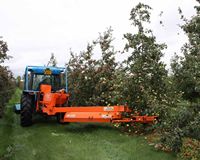
Pictures of the harvesting process can be viewed here.
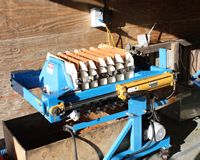
Cider production was the subject of our second visit which started at Peter
Mitchell's Orchard Centre at Hartpury near Gloucester. Peter does not
grow any apples but buys in local hand-picked fruit. He demonstrated how the
apples are first floated on water to enable any that are too badly damaged
to be removed before they are milled to produce a coarse pulp. The
pulp is placed in a series of polypropylene pockets which are then squeezed
in a hydraulic press (pictured right) to extract the juice. This is then fermented
in temperature controlled vats. A selected strain of bottom fermenting yeast
is added together with nitrogen and protein supplements to aid the growth
of the yeast.
The yeast is probably a hybrid between Saccharomyces cerevisiae and S. bayanus and related to the yeast used in champagne production. These strains prefer a lower temperature than the top fermenting strains of S. cerevisiae used for beer production. Initially the juice is maintained at 18-20oC to start the ferment but this is then dropped to around 14oC. It takes 14 days for fermentation to completely use up all the available sugar and the temperature is then raised to kill the remaining yeast. This settles out over two days after which this base cider can be drawn off.
Peter stores this in large bags of silvered plastic very similar to those in wine boxes. These keep the contents free from contact with the air and the base cider will store for up to 18 months. This raw cider is not very drinkable and must be blended to make the finished product. Fructose sugar is invariably added, even to 'dry' cider, as is some water and acid to 'balance' the pH before the final product is bottled for sale.
Pictures of this process can be viewed here.
Industrial production
The Group then went on to Westons Cider at Much Marcle in Herefordshire. Here
cider production is similar to that described by Peter Mitchell but on an
industrial scale. They can press 10 tons of fruit in 90min, fill 28,000 bottles
an hour and last year sold over 6million bottles of cider. With such large
scale production storage becomes a major issue especially the large oak vats
where they 'finish' the cider. In addition to 24 ciders, they
produce pear cider and perry.
The artisan
The final visit was to Gregg's Pit Cider run by James Marsden.
James is an artisan producer and like Peter Mitchell, prefers his apples picked
by hand. Some apples come from his own orchard and usually some from a neighbour.
Unfortunately this year winds brought down his neighbour's apples which
were then eaten by the cows he grazes in the orchard. His own orchard is some
300 years old and contains 33 varieties of cider apples and perry pears.
He uses an old stone press but polypropylene fabric replaces the traditional jute sacking to separate the layers of pulp. The cider is produced using a traditional method still widely used in France. This involves using apples that are rich in tannin but low in nutrient. These are macerated at low temperature (around 5oC) and then calcium chloride added. At these low temperatures the pectin in the fruit turns to pectic acid which forms a gel with the calcium. This rises to the surface form a brown layer called a 'brown hat' or 'chapeau brun'. The clear liquid left when this 'hat' is removed is fermented slowly at low temperature with natural yeast to produce a naturally sweet cider.
Plant of the Month
Hydrangea quercifolia, Hydrangeaceae
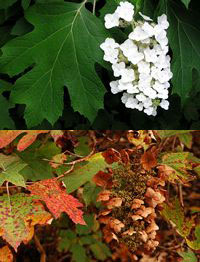
Hydrangeas are well known by gardeners for their showy inflorescence, which are composed of small and insignificant fertile flowers surrounded by far larger, yet sterile ray florets. Many hydrangeas have coloured flowers, with the flower colour being somewhat dependant on the pH of the soil the plant is growing in. The anthocyanin pigments turn from red in alkaline soil to blue in acid soil, dependant on the availability of Al3+ ions. The oak-leaved hydrangea, however, has snowy white flowers from mid-summer to mid-autumn and there are several cultivars available such as 'Snow Queen' and Snow Flake'. The flowers on these plants will be white regardless of the soil type upon which they grow.
Medicinal Plant of the Month
Dichroa febrifuga, Hydrangeaceae
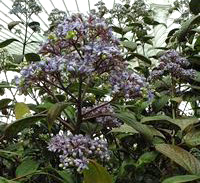
The name Dichroa means twice-coloured from the Greek dis and chroa. The flowers are white to pale pink but the fruits when they form are a stunning royal blue colour. Febrifuga means fever-dispelling, and indeed this plant has long been used in traditional Chinese medicine against malarial fever. The active principles were isolated as long ago as the 1940s and found to be two isomers in equilibrium with each other whilst in solution. Named febrifugine and isofebrifugine, they rapidly kill the malarial parasite and there are no resistance problems. They are however too toxic to the liver to be progressed as a clinical drug. Research is underway to develop analogues that have a better safety profile.
News from our Associates

The CHA will be running the UK Pavilion at Hortifair in Amsterdam from
1 - 4 Nov. It will be hosting a seminar at the event on
3 Nov to promote the latest developments and technology from the British
commercial horticulture industry.
In addition the CHA is still recruiting companies wishing to exhibit at IPM Essen, Fruit Logistica (Berlin), Salon du Vegetal (Angers) and Hortec Kenya
Horticulture Industry News
For the very latest horticultural news follow us on Facebook and or
Twitter.
Money for tree research
Millions of trees could be lost to disease in the UK in the next few years
unless urgent action is taken, Environment Secretary Caroline Spelman has
warned. She was speaking at the launch of a new government drive to combat
the exotic pests and diseases threatening the health of trees in the UK. People
trying to smuggle potentially-infected plants and cuttings into the UK will
face more robust enforcement, and the government is putting £7 million
into research on combating new or exotic tree and plant pathogens. The Tree
Health and Plant Biosecurity Action Plan, a joint initiative with the Forestry
Commission, sets out how to tackle serious tree and plant pests and diseases.
However, the funding is not new money from the Treasury. It is funding from
within Defra's existing science budget that will be allocated to tree health
and biosecurity research. More
Artificial vision to detect rotten oranges
A machine that uses artificial vision and Ultra-Violet rays to scan through
citrus fruits and get rid of rotten ones has been developed in Spain. Usually
the inspection is done manually in dark rooms, also using UV light. But this
can harm workers' eyes and skin, so they must wear protective clothing and
goggles. The team from the Valencian Institute of Agrarian Research said that
their technology could eliminate these risks. More
Robot strawberry pickers
Scientists at the National Physical Laboratory have developed an imaging technology
which can identify the ripeness of strawberries before they are picked. The
developers now hope to work with the agricultural industry to turn it into
fruit picking robots that will reduce food waste and improve productivity.
Successful trials have been completed on strawberries as well as a number
of other crops. The software has also been designed to 'learn' based on past
experience, so tests for new crops can be quickly developed. The work began
in 2009, as a project to identify the ripeness of cauliflowers, which was
a problem for pickers due to their leafy exterior is now being developed for
a wider range of fruit and vegetables. More
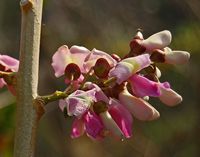
Planting
trees that improve soil quality can help boost crop yields for African farmers,
an assessment shows. Fertiliser tree systems (FTS) also help boost food security
and play a role in 'climate proofing' the region's arable land.
The system is based on the familiar use of nitrogen-fixing legumes to boost
soil fertility. Instead of clovers or alfalfa the system uses nitrogen-fixing
trees like the pigeon pea, Cajanus cajan, Gliricidia sepium (picture right by Wibowo
Djatmiko) and the apple-ring acacia, Faidherbia albida. More
Phytophthora lateralis found in Devon
The first outbreak in England of Phytophthora lateralis has been
confirmed on Lawson's cypress at an industrial site in the southwest. There
have been previous outbreaks in Scotland and Northern Ireland, as well as
in the Netherlands and France. Phytophthora lateralis causes an often
fatal disease of trees, mainly in the genus Chamaecyparis. Lawson's
cypress (C. lawsoniana) is the primary host, other potential hosts
include the Pacific Yew (Taxus brevifolia) and White Cedar (Thuja
occidentalis). The infection is thought to have been introduced several
years ago and an investigation is underway aimed at identifying the cause
of the outbreak.
Protein tags that measure light
Plant movement in response to light, phototropism, is controlled by a series
of molecular-level signals between proteins inside and between plant cells.
University of Missouri scientists report for the first time the role a critical
protein plays in this molecular signalling pathway. Directional light is sensed
through the action of two light-sensing proteins, phototropin 1 and phototropin
2. These proteins initiate the phototropic signalling response in conjunction
with a third protein, called NPH3. Using a combination of genetic and biochemical
methods, the scientists found that NPH3 functions as part of a protein complex
that modifies phototropin 1 by adding a small protein 'tag' called
ubiquitin. Either a single ubiquitin or a chain of ubiquitin proteins is added,
depending on the amount of light the plant 'sees.' More
The return of 2-4-D
Dean Riechers of the University of Illinois and his team suggest that tank-mixing
auxinic herbicides with glyphosate may be the best short-term option available
to farmers interested in broad-spectrum, post-emergence weed control. 'Resistance
has become a big problem,' Riechers said. 'In 1997, researchers
predicted that glyphosate resistance would not be a big issue in Round-Up
Ready crops. For the most part, they were right. But they underestimated a
few weed species and resistance mechanisms.' Since the 1950s, 29 auxin-resistant
weed species have been discovered worldwide. In comparison, 21 glyphosate-resistant
weed species have been discovered since 1996 when Round-Up Ready soybeans
were commercialised. Interestingly enough, two of the most problematic weeds
in Round-Up Ready soybean and cotton, common waterhemp (Amaranthus tuberculatus)
and Palmer amaranth (Amaranthus palmeri) are not yet on the list
of auxin-resistant weeds. More

A
team at the University of Innsbruck have discovered a previously unknown chlorophyll
decomposition product in the leaves of Norway maples. The different spatial
arrangement of its atoms is indicative of a different decomposition pathway
than those of other deciduous trees. In the autumn, deciduous trees reabsorb
critical nutrients, such as nitrogen and minerals, from their leaves. This
releases the chlorophyll from the proteins that normally bind it.
However, chlorophyll is phototoxic in this free form, and can damage the tree when exposed to light. It must therefore be 'detoxified' by decomposition. Various colourless tetrapyrroles, molecules with a framework of four nitrogen-containing five-membered carbon rings, accumulate in the dying leaves of higher plants, and have been classified as decomposition products of chlorophyll.
This premise is beginning to get a little shaky. The current study found none of the typical breakdown products in yellow-green or yellow Norway maple leaves. Instead, the main product found was a dioxobilane, which resembles a chlorophyll breakdown product found in barley leaves. There is clearly a chlorophyll breakdown pathway occurring in Norway maple leaves that differs from those previously known. The structure of this newly discovered dioxobilane is reminiscent of bile pigments, which are products of the breakdown of blood heme. This supports the idea that chlorophyll breakdown is not only a detoxification process; the resulting decomposition products could also play a physiological role (picture by FlickrLickr). More
Early Detection of Plant Disease
Each year, plant viruses and fungal attacks lead to crop losses of up to 30
percent. That is why it is important to detect plant disease early on. Yet
laboratory tests are expensive and often time-consuming. Researchers at the
Fraunhofer Institute for Molecular Biology and Applied Ecology are now working
on a new quick test that will provide the farmer a low-cost analysis in the
field. At the heart of the test is a magnetic reader. The device has several
excitation and detection coils arrayed in pairs.
The excitation coils generate a high- and low-frequency magnetic field, while the detection coils measure the resulting mixed field. If magnetic particles penetrate the field, the measuring signal is modified. The result is shown on a display, expressed in millivolts. This permits conclusions about the concentration of magnetic particles in the field. Researchers are making use of this mechanism to track down pathogens. What is detected is not the virus itself but the magnetic particles that bond with the virus particles. More
Smarter toxins help crops fight resistant pests
One of the most successful strategies in pest control is to endow crop plants
with genes from the bacterium Bacillus thuringiensis, or Bt, which
code for proteins that kill pests attempting to eat them. But insect pests
are evolving resistance to Bt toxins, which threatens the continued success
of this approach. A research team at the University of Arizona reports the
discovery that a small modification of the toxins' structure overcomes the
defences of some major pests that are resistant to the natural, unmodified
Bt toxins.
Unlike conventional broad-spectrum insecticides, Bt toxins kill only a narrow range of species because their potency is determined by a highly specific binding interaction with receptors on the surface of the insects' gut cells. Resistance occurs when these receptors are modified by mutation. A simple modification of the Bt gene enables the BT toxin to by-pass these receptors and thus the resistance. More
Weevils tackle the invasive water fern Azolla
The fast-growing water fern, Azolla filiculoides, can rapidly become
a major nuisance in ponds and waterways. It forms a dense mat on the surface
of the water, depriving other plants, fish and invertebrates of light and
oxygen. A recent outbreak has covered a 2.5 mile (4km) stretch of the River
Till near Lincoln. The Environment Agency is using the azolla weevil, Stenopelmus
rufinasus, to control this outbreak. The weevil feeds off the Azolla
without harming native species. The Environment Agency put 8,000 weevils in
at this particular site and in a couple of weeks they will go up to millions
of weevils, more than enough to control the amount of weed in the river. More
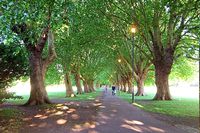
New
research by scientists at the University of Southampton has shown how London's
trees can improve air quality by filtering out pollution particulates, which
are damaging to human health. They show that the trees of the Greater London
Authority (GLA) area remove somewhere between 850 and 2000 tonnes of particulate
pollution (PM10) from the air every year. An important development in this
research is that the methodology allows the prediction of how much pollution
will be removed in the future as the climate and pollution emissions change.
The work shows the real benefits of the planned increase in the number of street trees in London and throughout England, including the GLA's plan to increase the area of urban trees by 2050 and the UK government's 'Big tree plant' initiative. They found that by targeting tree planting in the most polluted areas of the GLA area and particularly the use of a mixture of trees, including evergreens such as pines and evergreen oak, would have the greatest benefit to future air quality in terms of PM10 removal. (picture by Cmglee)
New product for Phytophthora prevention
PlantTrust, a groundbreaking new product providing improved and cost-effective Phytophthora prevention and improved crop quality, has been unveiled
by Everris (formerly Scotts Professional). PlantTrust employs an breakthrough
platform technology - Controlled Release Control (CRC). This new advanced
coating system provides gradual, steady and complete diffusion of the active
ingredient - in this case Fosethyl Aluminium - into the substrate.
The active ingredient is coated on to NPK fertiliser granules. Each PlantTrust
granule controls the release of both fungicide and fertiliser ensuring the
plant has exactly what it needs providing five months protection against Phytophthora cinnamomi, while feeding the crop for 2-3 months. More
New insight into plant immune defences
Plants are under constant attack from disease-causing organisms and to protect
themselves they have developed a simple immune system. One defence mechanism
is to trigger threatened cells to die and so remove the food source from the
invading pathogen. Professor Gary Loake and his team at the University of
Edinburgh have uncovered what is happening inside the cells to control this
process and the role of the enzyme NADPH oxidase. Plants generate a short,
sharp shock that kills off the cells around where the pathogen is trying to
invade and essentially starves it out.
But somehow the plant must make sure that the effect is limited to that area. When a plant is attacked one of the common responses is to trigger the production of nitric oxide (NO) and a class of molecules known as 'reactive oxygen intermediates' (ROIs), which includes things like hydrogen peroxide and 'free radicals'. The team has found that there is a feedback loop where, as the levels of NO go up, NADPH oxidase is altered by the addition of an NO molecule to its structure so that it doesn't work so well. This causes the level of ROIs to drop and cell death tails off.
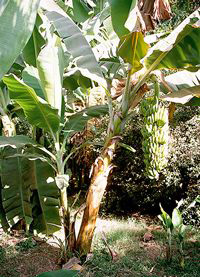
Banana
is the most severely nematode damaged crop worldwide and commercial plantations
use pesticides for their control. These can be environmentally damaging and
cause health problems for agricultural workers. Moreover, these chemicals
are too expensive for small-scale subsistence farmers in Africa where losses
are most acutely felt. Now two safe technologies developed in the UK for potatoes
are being used to control the nematodes and eliminate the yield losses.
The initial technology was developed at the University of Leeds and the novel genes transferred into plantain at the International Institute of Tropical Agriculture (IITA). Leeds and IITA together have shown that the technology is effective and a GM field trial is now planned for 2012. If trials are successful uptake could be rapid as the majority of banana consumers in Africa live in countries that favour deployment of [GM] plant biotechnology.
British research leads to UK launch of Beneforté broccoli
A new variety of broccoli with higher levels of a key phytonutrient is now
available in UK shops thanks to experts working on both the biology of plants
and the link between human nutrition and health. The new broccoli, which will
be known as Beneforté, was developed at the Institute of Food Research
and the John Innes Centre. The researchers used conventional breeding techniques
to develop the new broccoli, which contains two to three times the level of
the phytonutrient glucoraphanin than standard broccoli. Glucoraphanin is a
beneficial chemical that is found naturally in broccoli and is thought to
help explain the link between eating broccoli and lower rates of heart disease
and some forms of cancer. Glucoraphanin also leads to a boost in the body's
antioxidant enzyme levels.
Quotes of the Month
'If a cluttered desk signs a cluttered mind, of what, then, is an empty desk a sign?'
Albert Einstein
Events Calendar
Hortifair
1 - 4 Nov, Amsterdam RAI
Amsterdam, The Netherlands
Scotsturf
2 - 3 Nov, Institute of Groundsmanship
Edinburgh, UK
Postharvest and
Quality Management of Horticultural Products of Interest for Tropical Regions
2 - 4 Nov, International Society for Horticultural Science
Bogota, Colombia
Pyrethrum,
The Natural Insecticide
2 - 4 Nov, International Society for Horticultural Science
Hobart, Australia
Plants in a chemical world
7 Nov, Oxford Botanic Garden
Oxford, UK
Southern
Growers Exhibition
9 Nov, Southern Growers
Chichester, UK
GM crops - where do we go from here?
14 Nov, Oxford Botanic Garden
Oxford, UK
International
Symposium on Tropical Wines
14 - 16 Nov, International Society for Horticultural Science
Chiang Mai, Thailand
World Fruit and Vegetable
Expo
16 - 17 Nov, WVF Expo
London, UK
Management
of Tuta absoluta
16 - 18 Nov, EPPO/IOBC/FAO/NEPPO
Agadir, Morocco
Onion
and Carrot Conference
16 - 17 Nov, Processed Vegetables Growers' Association
Peterborough, UK
Epigenetics
and Tomato Improvement
17 Nov, Society of Biology
Sutton Bonnington, UK
Medicinal and Aromatic
Plants
20 - 23 Nov, International Society for Horticultural Science
Antigua, Guatemala
Achieving food security and sustainability for 9 billion
21 Nov, Oxford Botanic Garden
Oxford, UK
Symposium
on New Floricultural Crops
22 - 25 Nov, International Society for Horticultural Science
Buenos Aires, Argentina
IAgrM BIAC National Conference
23 Nov, British Institute of Agricultural Consultants
Details to Follow
Trees
- A cut above the rest
24 Nov, Oxford Botanic Garden
Oxford, UK
Frontiers
of Citrus
27 - 30 Nov, International Society for Horticultural Science
Tel Aviv, Israel
Solanaceae and Cucurbitaceae
Joint Conference
28 Nov - 2 Dec
Kobe, Japan
Biopesticide
International Conference
28 - 30 Nov, Journal of Biopesticides
Palayamkottai, India
Biopesticides
29 Nov, Association of Applied Biologists
Marston, UK
Advances
in Biological Control
30 Nov, Association of Applied Biologists
Marston, UK
National
Landscape Awards
2 Dec, British Association of Landscape Industries
London, UK
Quality Management
in Supply Chains of Ornamentals
3 - 6 Dec, International Society for Horticultural Science
Bangkok, Thailand
Postharvest Quality
Management of Root and Tuber Crops
3 - 6 Dec, International Society for Horticultural Science
Bangkok, Thailand
Postharvest
Pest and Disease Management in Exporting Horticultural Crops
3 - 6 Dec, International Society for Horticultural Science
Bangkok, Thailand
Quality Management
in Postharvest Systems
3 - 6 Dec, International Society for Horticultural Science
Bangkok, Thailand
Cashew Nut
9 - 12 Dec, International Society for Horticultural Science
Madurai, India
Vegetable
Nutrition and Fertilization: Vegetable Farms Management Strategies for Eco-Sustainable
Development
19 - 22 Dec, International Society for Horticultural Science
Giza, Egypt
International
Symposium on Orchids and Ornamental Plants
9 - 13 Jan, International Society for Horticultural Science
Chiang Mai, Thailand
International
Advances in Pesticide Application
10 - 12 Jan, Association of Applied Biologists
Wageningen, The Netherlands
All Africa Horticultural
Congress
15 - 20 Jan, International Society for Horticultural Science
Skukuza, South Africa
Brassica Growers Association
Conference and Exhibition
17 Jan, Brassica Growers Association
Grange-de-Lings, UK
New
research into plant colour production
19 Jan, Bristol Botanic Garden
Bristol, UK
Harrogate Week
22 - 26 Jan, British and International Golf Greenkeepers
Association
Harrogate, UK
International
Symposium on Banana
23 - 26 Jan, International Society for Horticultural Science
Chiang Mai, Thailand
A
Garden for a Thousand Years
26 Jan, Oxford Botanic Garden
Oxford, UK
If you would like to advertise a forthcoming event please contact. zoe.daniel@soci.org
Horticulture Group Contact Details
For submitting ideas or to volunteer to be part of a committee or a group, please contact:
Chairman - Peter Grimbly
Meetings Secretary - Marion Stainton
Minutes Secretary - Margaret Waddy
Newsletter Co-ordinator - Sue Grimbly, E: scihortigroup@btinternet.com
Group Coordinator - Zoe Daniel zoe.daniel@soci.org T: +44 (0)20 7598 1594

